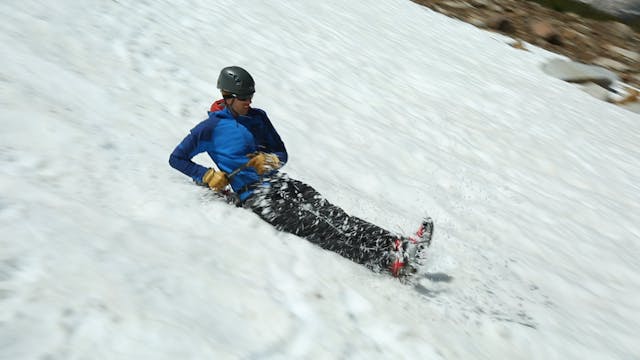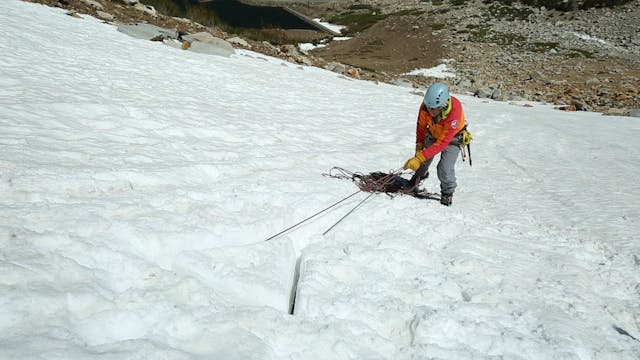Alpine: 11. The Self-Arrest
Alpine & Mountaineering
•
3m 59s
In this video we review the self-arrest technique, a way of stopping a slip and fall on steep snow. Self arresting involves using the ice axe as a brake when one has slipped down a snow slope, and is a tool that should be automatic for every mountaineer. It takes practice, and mastery is key.
Self arrest only works on snow slopes where the pick can penetrate and grip the snow. It is hopeless on very firm snow or ice, or very steep snow. As such a mountaineer should not rely on the self arrest as a means of safety, but should rely instead on good judgment and confidence on the terrain in the conditions at hand.
The self arrest is a last ditch effort to correct an error in decision making that can save your life. Consider rappelling if the slope looks difficult to descent on foot.
To self arrest:
Step 1: Hold the axe in self arrest grip, with the palm of the hand over the head of the axe. The adze will face forward, with the pick facing backwards.
Step 2: If you fall, yell “falling!” If you are on a rope, this will help alert your team to arrest your fall.
Step 3: Bring the head of the axe up to the same shoulder as the hand that the axe is being held in. Imagine you’re answering the “ice axe phone.” At the same time with the opposite hand, grasp the shaft near the spike near the opposite hip.
Step 4: Drop onto the shoulder, driving with the pick of the axe. Pull up on the opposite hand (the one at your hip) to torque the axe into the snow. This should require little strength and instead rely upon excellent, well-honed techniques.
While the video depicts completing a sort of push-up on the snow, this is not entirely correct. An exaggerated push-up is a sure way to lose control of the ice axe, as it puts the axe further from your body while hurtling downhill. We would argue that the climber’s technique in this video is too far from the axe. There should be NO space between the body and the ice axe.
Step 5: Kick your toes into the snow to help slow your fall as you continue to fight to keep the rest of your body elevated, almost in an A frame shape, and off the snow.
If wearing crampons, avoid kicking your feed into the snow as that’s a great way to break an ankle or flip over. Instead dig your knees into the slope. As you slow down, it may become appropriate to kick your crampons into the snow.
Hopefully this worked, and by now you have stopped your fall. If not...then TRY, TRY, and TRY AGAIN!! ….Fight with all you have, and do whatever it takes to arrest your fall.
A slip and fall is not always predictable. You might find yourself on your back, head rocketing downhill, sliding sideways, or on your back with feet downhill. Practice the self arrest in many different positions (without crampons, to reduce risk of injury during practice). Always try to get your head uphill, feet downhill, facing the slope.
Practice, learn this skill, and get comfortable with it. Have the self arrest in your bag of tricks but hope you never need to use it!
We hope you found this video helpful. Feel free to comment below with questions or thoughts!
Please remember, climbing is inherently dangerous. Climb at your own risk.
Up Next in Alpine & Mountaineering
-
Alpine: 12. How to Glissade
In this video we look at proper glissading technique. This is a fancy term for sliding down the snow; either standing or seated. Glissading can be a fun and quick way to descend snow. It can also create a dangerous situation, and has been the cause of numerous accidents.
A few considerations...
-
Alpine: 13. Snow Anchors - Creating a...
In this video we build a snow bollard. This is a type of snow anchor that can be used for rappelling when you have no other anchor options. They are also great because you simply use the snow and your rope, and leave nothing behind.
Bollards can be time consuming to build and finicky to perfec...
-
Alpine: 14. Snow Anchors - Equalization
In this video we look at how to equalize snow anchors.
Building snow anchors follows many of the same principles as building rock anchors. The force placed on snow anchors tends to be less than on rock. The exception to this would be haul systems for crevasse rescue.
When building anchors ...


